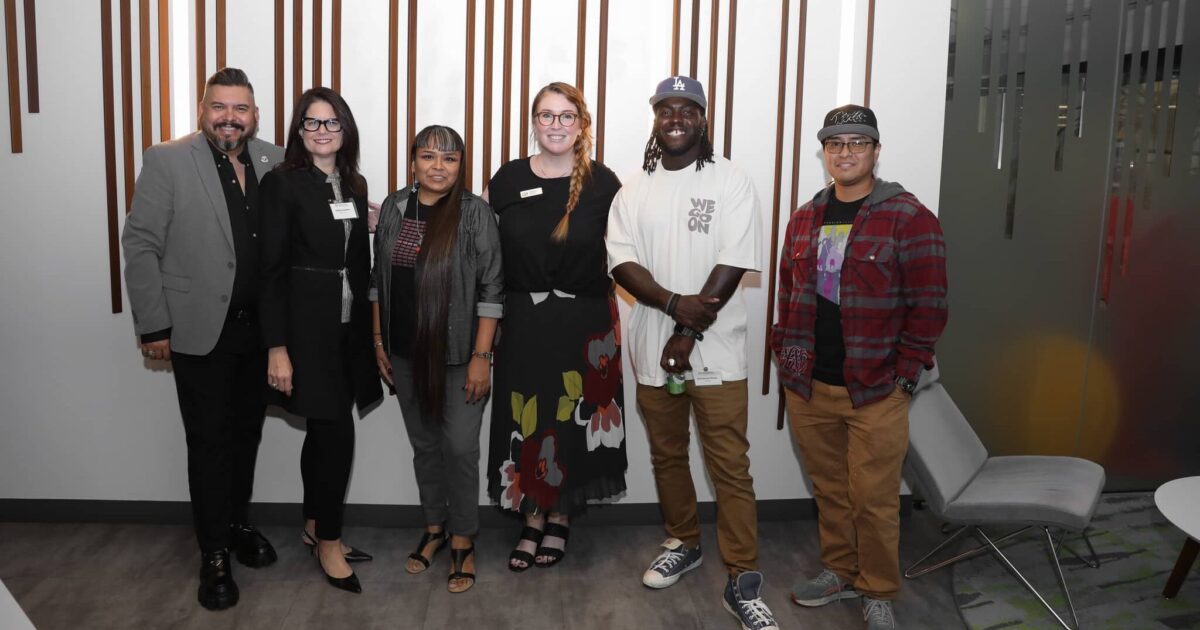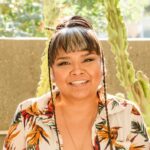

Ambassador Event: The Business of Art
Published: 12/11/2023
Exploring the synergies between the business community and local artists
The arts continuously play a prominent role in promoting cultural identity and diversity, documenting historic moments through an individual lens and supporting the local and regional economy.
On Nov. 17, Greater Phoenix Economic Council (GPEC) hosted the Business of Art Ambassador Event adjacent to the opening of its newest hybrid exhibit. The evening event included a panel with artists who collaborated on Downtown Phoenix’s Super Bowl LVII mural and a fireside chat with insights on how private companies, municipalities, nonprofits and the public can open lines of communication to collaborate with and support local artists.
The panel consisted of:
- Eunique Yazzie, Artist & Co-Founding Member of Cahokia: SocialTech + ArtSpace
- Jesse Yazzie, Artist
- Giovannie Dixon, Artist
- Stefanie Carson, GPEC Art Director (Moderator)
GPEC President and CEO Chris Camacho opened the event by noting “arts and culture are the bedrock of a community brand and the community identity,” adding the arts play a vital role for us to understand our heritage on both a community and individual level. Since 2008, GPEC has hosted 14 art exhibitions featuring 550 artists and more than 980 pieces, Carson shared, connecting the region’s vibrant local arts with the business ecosystem.
Making the Super Bowl LVII Mural: artists collaborate for showcase of authenticity and heritage
In a lively discussion, the artists shared their experiences and impressions from working on a large-scale mural project commissioned by the NFL for Superbowl LVII that reflected Indigenous culture and the region’s artistic style and heritage.
Eunique Yazzie, whose roots are from Canyon de Chelly in the Navajo Nation heartlands, led the group of artists as project manager. Apart from being a working artist, muralist and illustrator, she is the co-founder of Cahokia PHX collective which creates a space that allows Indigenous artists to see their vision to completion. Together, artists can “amplify each other and amplify Indigenous voices … and use culture and art to tell our stories,” Eunique Yazzie said.
Local artist La Morena was approached by the NFL to create a mural inspired by her Super Bowl ticket design. Recognizing the magnitude of the 9,000 square-foot design, La Morena reached out to Cahokia PHX. “There is power in creative numbers and in having a cultural space that … can speak the language that she speaks,” Eunique Yazzie said. One of the unique challenges while envisioning the mural was the balance between the idea of the piece of art representing and honoring the story, land and culture of downtown Phoenix yet simultaneously serving as a large advertisement for the NFL. “The field is the land, and we are both caring for this field in the same way. As people and fans surround a field to cheer on their favorite teams, Native people do that with their crops, with their harvests, with their homes, with their communities,” she added.
The project involved input by many Native American artists including Jesse Yazzie, an emerging Navajo artist from Phoenix. He shared that this was a pivot point in his art career and it was at times challenging to appreciate how important the mural was, “especially when you are on the wall…. right in the middle of a huge flower,” but now, from the distance of having completed the project, it has been eye-opening for him to see what affect this work has had on the artists involved, the community and the region. Jesse Yazzie is certain that him working on the mural as a Native artist gave other Native artists validation.
For Dixon, a local street artist whose large-scale murals can be seen throughout the Valley, it was a special experience to be on the wall and challenge himself. Albeit at times not that comfortable because of the size of the mural, Dixon said the project was “monumental.”
Eunique Yazzie discussed how this undertaking brought to light improvements that could be made in the collaboration between artists and communities to change the way creativity unfolds. For example, improved communication around regulations, insurance, staging equipment and on-site logistics such as access to parking and restrooms could have contributed to smoother execution of the project that the group had only 21 days to execute from start to finish.
The artists’ commitment to working together through unexpected challenges led to a lasting piece of public art that commemorates the history and origins of Greater Phoenix at a momentous time when millions of eyes were centered on the region.
Synergies between artists, businesses, and communities: The importance of connectedness and connectivity
The evening’s subsequent fireside chat brought together two leaders of arts and culture in Arizona who discussed the importance of fostering opportunities for businesses and organizations to collaborate with the community:
- Catrina Kahler, CEO of Artlink, Inc.
- Mitch Menchaca, Executive Director, Office of Arts and Culture, City of Phoenix
Collaboration between artists, nonprofits, municipalities and private businesses to create funding opportunities and organizational support that results in meaningful artwork reflective of the diversity of Greater Phoenix is crucial to support artists like those who contributed to the Super Bowl mural.
In the fireside chat, Kahler and Menchaca discussed new developments and programs that help support the region’s arts and culture ecosystem.
For Kahler and Artlink, which connects artists, businesses and community, it is important to celebrate the accomplishments of local talent. “We know the downtown Phoenix and central Phoenix community is rich in vibrancy, and the artists are very active,” she said.” The texture of this community is visible — you can feel it.”
The focus of Artlink extends beyond the art on the walls, Kahler stressed. It can also be seen in fashion, culinary, and around arts and culture. “It is about what kind of city we want to live in and what kind of city we want to build, and the kind of cities and communities we believe in, because we know we can make the best communities possible because of what the artists do.”
Kahler noted that the focus must be on these connections, including calls to artists, grant programs and partnerships to allow for the arts to be integrated and highly visible across the community. That need for connection led to Artlink projects such as the Phoenix Urban Guide and Artinerary.com, a new platform designed to easily direct visitors to artistic experiences throughout Downtown Phoenix.
Gensler Client Relations Manager and GPEC Ambassador Oscar De las Salas, who also serves on Artlink’s Board of Directors, presented the forthcoming Art d’Core Gala, Artlink’s annual event happening March 16, 2024, at the Phoenix Art Museum. De las Salas introduced Artlink as having a “decades-long impact highlighting local art,” adding, “the expansion of our city comes with the world of art.”
For Menchaca, collaborations such as the one with Artlink are crucial for expanding public art projects and supporting local and Indigenous artists. From capital improvement projects in infrastructure, such as a pedestrian bridge on route 202 to a mural commemorating the renaming ceremony of S'edav Va'aki Museum (formerly Pueblo Grande Museum), the Office of Arts and Culture is focused on geographic equity in the city.
“We are trying to split our resources in an equitable way, and one of the things that we do is [to] support nonprofit arts and cultural organizations and individual artists through grant-making programs,” he said.
Menchaca shared Phoenix is one of eight cities out of 150 applications that were recently selected as part of the Bloomberg Philanthropies’ Public Art challenge to receive up to a $1 million grant for temporary public art installations. Phoenix’s proposed project, ¡Sombra!, aims to address heat mitigation by encouraging public dialogue about the City’s extreme heat challenges and featuring shade and cooling installations by local artists. In addition, Phoenix’s General Obligation Bond Program passed on Nov. 7 will support the work of the Office of Arts and Culture with $500M allocated to arts and culture programs, parks and recreation improvements, historic preservation programs and a library expansion.
In addition to being essential in reflecting our culture and communities, projects like ¡Sombra! and large-scale public works like the Super Bowl mural make the arts highly visible and accessible across the region while contributing to the great lifestyle and livability Greater Phoenix is known for.
Meet the Panel

Eunique Yazzie
Artist & Co-Founding Member
Cahokia: SocialTech + ArtSpace

Giovannie Dixon
Artist

Jesse Yazzie
Artist

Catrina Kahler
CEO
Artlink, Inc.

Mitch Menchaca
Executive Director
Office of Arts and Culture, City of Phoenix

Stefanie Carson
Art Director (Moderator)
Greater Phoenix Economic Council